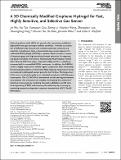A 3D Chemically Modified Graphene Hydrogel for Fast, Highly Sensitive, and Selective Gas Sensor
Author(s)
Wu, Jin; Tao, Kai; Guo, Yuanyuan; Li, Zhong; Wang, Xiaotian; Luo, Zhongzhen; Feng, Shuanglong; Du, Chunlei; Chen, Di; Miao, Jianmin; Norford, Leslie Keith; ... Show more Show less
DownloadPublished version (2.574Mb)
Terms of use
Metadata
Show full item recordAbstract
Reduced graphene oxide (RGO) has proved to be a promising candidate in high-performance gas sensing in ambient conditions. However, trace detection of different kinds of gases with simultaneously high sensitivity and selectivity is challenging. Here, a chemiresistor-type sensor based on 3D sulfonated RGO hydrogel (S-RGOH) is reported, which can detect a variety of important gases with high sensitivity, boosted selectivity, fast response, and good reversibility. The NaHSO3 functionalized RGOH displays remarkable 118.6 and 58.9 times higher responses to NO2 and NH3, respectively, compared with its unmodified RGOH counterpart. In addition, the S-RGOH sensor is highly responsive to volatile organic compounds. More importantly, the characteristic patterns on the linearly fitted response-temperature curves are employed to distinguish various gases for the first time. The temperature of the sensor is elevated rapidly by an imbedded microheater with little power consumption. The 3D S-RGOH is characterized and the sensing mechanisms are proposed. This work gains new insights into boosting the sensitivity of detecting various gases by combining chemical modification and 3D structural engineering of RGO, and improving the selectivity of gas sensing by employing temperature dependent response characteristics of RGO for different gases. Keywords: 3D reduced graphene oxide hydrogel; chemical modification; gas sensor; microheater; sulfonated
Date issued
2017-03Department
Massachusetts Institute of Technology. Department of ArchitectureJournal
Advanced Science
Publisher
Wiley
Citation
Wu, Jin et al. "A 3D Chemically Modified Graphene Hydrogel for Fast, Highly Sensitive, and Selective Gas Sensor." Advanced Science 4, 3 (March 2017): 1600319 © 2016 The Authors
Version: Final published version
ISSN
2198-3844